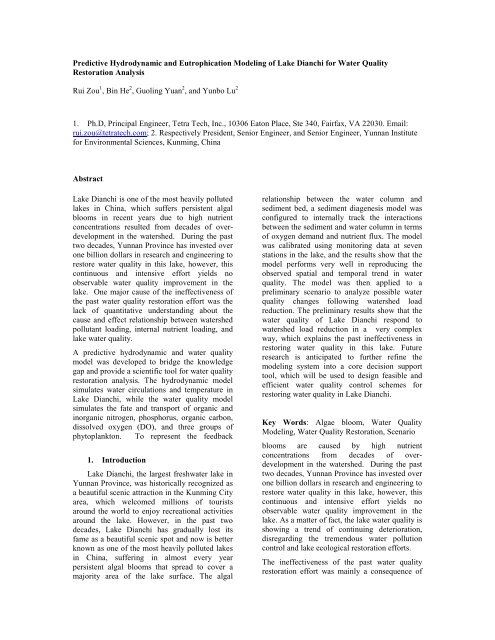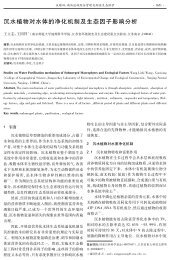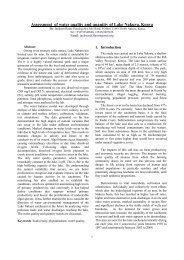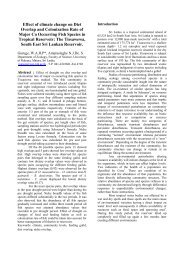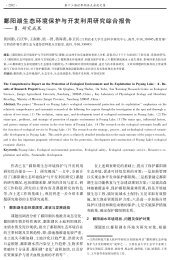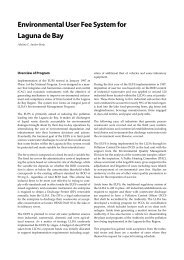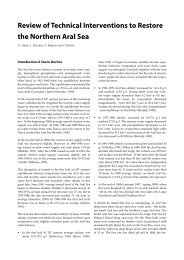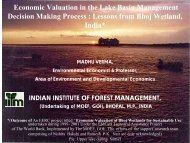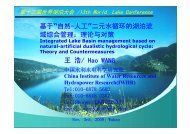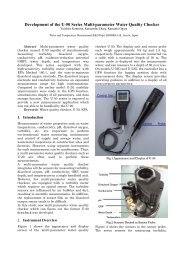Predictive Hydrodynamic and Eutrophication Modeling of Lake ...
Predictive Hydrodynamic and Eutrophication Modeling of Lake ...
Predictive Hydrodynamic and Eutrophication Modeling of Lake ...
Create successful ePaper yourself
Turn your PDF publications into a flip-book with our unique Google optimized e-Paper software.
outflow, rainfall <strong>and</strong> evaporation. In general,both the model results <strong>and</strong> observed data show adecreasing trend in elevation from January toJuly, then the elevation tends to rise from July toOctober, then the temporal trend level-<strong>of</strong>ftowards the end <strong>of</strong> the year, which reflects theintra-annual precipitation distribution wheremajority <strong>of</strong> the rainfall occur during the summerin this area. The hydrodynamic model was alsoevaluated by its simulated circulation pattern inFigure 3. Apparently, the model results showthat the circulation in the lake is dominated by acounter-clockwise flow filed while local microcirculationpatterns do exist, which matches thepast knowledge about the circulation in <strong>Lake</strong>Dianchi based on historically measured data.Both the elevation <strong>and</strong> circulation pattern resultssuggest that the hydrodynamic model likely hasrepresented the hydrologic balance <strong>and</strong> fluiddynamics well, serving a reasonable basis forfurther water quality modeling.After the hydrodynamic model was calibrated,the water quality simulation was turned on tosimulate the nutrient, phytoplankton, DO <strong>and</strong>water column-sediment interaction dynamics.The simulated water quality was compared withobserved data, <strong>and</strong> key kinetic parameters wereadjusted until a reasonable match between modelresults <strong>and</strong> data were achieved. Figures 4 to 6plot simulated NH4, DO, TN, <strong>and</strong> TPconcentrations against observed data at threemonitoring stations in <strong>Lake</strong> Dianchi. As shown,the model has reasonably reproduced both thespatial <strong>and</strong> temporal patterns <strong>of</strong> the observeddata. As shown in Figures 4 <strong>and</strong> 5, NH4concentration drops sharply during the first threemonths, which was likely caused by the lack <strong>of</strong>sufficient inflow loading to <strong>of</strong>fset theconsumption by an early spring algal bloom inthe lake. Accompanying the sharp drop in NH4,we can observe in both the model results <strong>and</strong>measured data that DO tend to increase for thatperiod, which also suggests a likely spring algalbloom.Figures 4 to 6 demonstrate that during thesummer period, DO concentration can rise tovery high level well above the saturation level.This is caused by the intensive summer algalbloom in the lake. Comparing the magnitude <strong>of</strong>summer DO at the north lake stationHuiwanzhong <strong>and</strong> that at the south lake stationHaikouxi, it is obvious that the peak DO value atthe north lake is significantly higher than that atthe south lake, suggesting a more intensive algalbloom in the north lake. This pattern agrees withthe general observation in <strong>Lake</strong> Dianchi, <strong>and</strong> canbe explained by the high nutrient input loadingfrom Daqinhe River <strong>and</strong> Panlongjiang River.During the dry period, the loading signal fromthe tributaries is significant only at the north lakestation Huiwanzhong. However, during the wetperiod, we can observe spikes <strong>of</strong> increasednutrient concentration at all the stations. It isinteresting to note that after watershed loadingscaused a spike in NH4 concentration, the spikewould turn into a sharp downtrend until anexternal loading event produces another spike.The downturn <strong>of</strong> NH4 following a spike is anindicator <strong>of</strong> stimulated algae activities caused byincreased nutrient concentration, which quicklyuptake inorganic nutrient <strong>and</strong> depleteconcentration in the water column. Thesephenomenon clearly indicate that the waterquality in <strong>Lake</strong> Dianchi is significantly impactedby the watershed loading, <strong>and</strong> the temporaldistribution <strong>of</strong> incoming loading largelydetermine how the lake water quality vary overtime.In summary, the model in general catches thespatial <strong>and</strong> temporal distribution <strong>of</strong> water qualitywell, suggesting it likely to be a reasonablenumerical representation <strong>of</strong> the prototypesystem. The model-data comparison does showminor disparity between the model result <strong>and</strong>data at certain locations <strong>and</strong> times, which can beattributed to the uncertainty in both the model<strong>and</strong> data. Future research will be targeted tocollect more data to characterize the incomingloading as well as the in-lake water qualitypattern. Particularly, a more accurate watershedmodel is anticipated to be developed to providemore robust boundary condition than does theGWLF model.Preliminary Model ApplicationThe purpose <strong>of</strong> a hydrodynamic <strong>and</strong> waterquality model is to serve as a platform forevaluating various water quality restorationschemes. In this study, the model was applied toconduct a preliminary scenario analysis throughsimulating how the in-lake algal bloom intensityresponds to load reductions at all the tributariesexcept for Daqinghe River <strong>and</strong> PanlongjiangRiver. The purpose is to illustrate how the loadreductions at discrete tributaries would haveimpact on the algal bloom intensity in the lake.To execute such an analysis, a baseline scenariowas formulated which was based on the existingloading level as in the calibration model, butrecycling the boundary conditions for 20 years to
simulate the long term trend, <strong>and</strong> the results onthe 20 th year were used to be the basis <strong>of</strong>comparison (Figure 7). The reduction scenariothen was configured based on the baselinemodel, but removing the nutrient loading for allthe inflow tributaries except for Daqinghe River<strong>and</strong> Panlongjiang River, <strong>of</strong> which the loadinglevel are the same as in the baseline. Thereduction scenario model was also simulated for20 years <strong>and</strong> the results on the 20 th year wereplotted in Figure 8. Comparing Figures 7 <strong>and</strong> 8,it was observed that without reducing thenutrient from Daqinghe <strong>and</strong> Panlongjiang Rivers,the algal bloom in <strong>Lake</strong> Dianchi maintain thesimilar level <strong>of</strong> intensity as in the pre-reductioncondition even though all other tributaries areextremely treated. This result suggests thedifficulty in achieving significant depression <strong>of</strong>algal bloom intensity for <strong>Lake</strong> Dianchi. It mightrequire much more drastic load reductions <strong>and</strong>engineering measures to make it possible tosignificantly depress the algae bloom in <strong>Lake</strong>Dianchi. From the modeling result we canunderst<strong>and</strong> why the tremendous pollutionmanagement efforts in the past decades onlyresult in no observable improvement in the waterquality in the lake. In future research, weanticipate that the model will be further refinedto serve as the core component <strong>of</strong> the decisionsupport tools to help design robust <strong>and</strong> efficientwater pollution control <strong>and</strong> water qualityrestoration schemes for <strong>Lake</strong> Dianchi. The modelwill be potentially used to evaluate different loadreduction schemes such as how much wouldneed to be reduced from each tributariesincluding Daqinghe <strong>and</strong> Panlongjiang, <strong>and</strong> howmuch need to be reduced for internal sources,<strong>and</strong> what will happen if we restore macrophyteReferences1. Blumberg, A.F. <strong>and</strong> Mellor, G.L.(1987). “A description <strong>of</strong> a threedimensionalcoastal ocean circulationmodel”. In: Three-dimensional coastal<strong>and</strong> ocean models, coastal <strong>and</strong> estuarinescience, Vol. 4. AmericanGeographical Union, pp. 1-19.2. Cerco, C.F. <strong>and</strong> Meyers, M. (2000).“Tributary refinements to ChesapeakeBay model”, Journal <strong>of</strong> EnvironmentalEngineering, ASCE, 124 (2), 164-174.3. Chapra, S.C. (1997). Surface WaterQuality <strong>Modeling</strong>. The McGRAW-in the lake, as well as implementing othercomprehensive watershed management <strong>and</strong>engineering measures.Summary <strong>and</strong> ConclusionsA hydrodynamic <strong>and</strong> water quality model wasdeveloped to simulate the fate <strong>and</strong> transport <strong>of</strong>nutrient, along with eutrophication dynamics in<strong>Lake</strong> Dianchi, China. The modeling study hasshown that the EFDC modeling framework iscapable <strong>of</strong> representing the hydrodynamics <strong>and</strong>water quality process in the lake. The modelexplicitly simulates the physical, chemical, <strong>and</strong>biological processes which are very importantfor underst<strong>and</strong>ing the eutrophication dynamics inthe lake. Overall, the model was shown to havereproduced the observed water qualityconcentrations at locations throughout the lake.The preliminary scenario analysis shows that itwould be very hard to achieve observabledepression in algal bloom intensity in the lake.Even by reducing all nutrients from thetributaries except for Panlongjiang River <strong>and</strong>Daqinghe River, the resulted long term responsein algal bloom intensity to the load reduction isnegligible. This result explains why thetremendous pollution control investment duringthe past decades didn’t result in appreciablewater quality improvement in the lake. Futureresearch would be focused on refining the modelwith more intensive <strong>and</strong> accurate data, <strong>and</strong> thenapplying the model to evaluate various potentialpollution control schemes <strong>and</strong> help designfeasible <strong>and</strong> efficient ways to restore the waterquality in <strong>Lake</strong> Dianchi.HILL Company, INC., New York,USA.4. DiToro, D.M. <strong>and</strong> Fitzpatrick, J.J.1993. Chesapeake Bay Sediment FluxModel. Contract Report EL-93-2, USArmy Engineer Waterways ExperimentStation, Vicksburg, MS.5. Hamrick, J.M. (1992). A threedimensionalenvironmental fluiddynamics computer code: Theorectical<strong>and</strong> computational aspects. Specialpaper 317, the College <strong>of</strong> William <strong>and</strong>Mary, Virginia Institute <strong>of</strong> MarineScience, Williamsburg, Va.6. Hamrick, John M. (1996). User’sManual for the Environmental Fluid
Dynamics Computer Code. SpecialReport No. 331 in Applied MarineScience <strong>and</strong> Ocean Engineering.Department <strong>of</strong> Physical Sciences,School <strong>of</strong> Marine Science, VirginiaInstitute <strong>of</strong> Marine Science, TheCollege <strong>of</strong> William <strong>and</strong> Mary,Gloucester Point, VA.7. Park, K., Kuo, A., Shen, J., <strong>and</strong>Hamrick, J. (1995) (rev. by Tetra Tech,Inc. 2000). A Three-dimensional<strong>Hydrodynamic</strong>-<strong>Eutrophication</strong> Model(HEM-3D): Description <strong>of</strong> WaterQuality <strong>and</strong> Sediment ProcessSubmodels (EFDC Water QualityModel). Special Report No. 327 inApplied Marine Science <strong>and</strong> OceanEngineering.8. Lung, W.S. (2001). “Water Quality<strong>Modeling</strong> for Wasteload Allocations<strong>and</strong> TMDLs.” John Wiley& Sons, Inc.,NY.9. Tetra Tech, Inc (2008). <strong>Hydrodynamic</strong><strong>and</strong> water quality modeling to SupportRestoration <strong>of</strong> the Salton Sea,California. Prepared for Salton SeaAuthority, La Quinta, CA.10. Zou, R., Bai, S., <strong>and</strong> Parker, A. (2008a)<strong>Hydrodynamic</strong> <strong>and</strong> eutrophicationmodeling for a tidal marsh impactedestuarine system using EFDC. Coastal<strong>and</strong> Estuary <strong>Modeling</strong>, 561-589.11. Zou, R., Lung, W.S., <strong>and</strong> Wu, J.(2008b), Multiple-pattern parameteridentification <strong>and</strong> uncertainty analysisapproach for water quality modeling.Ecological <strong>Modeling</strong>, doi:10.1016/J.ecolmodel.2008.11.02112. Zou, R., Carter, S., Shoemaker, L.,Parker, A., <strong>and</strong> Henry, T., (2006), AnIntegrated hydrodynamic <strong>and</strong> waterquality modeling system to supportnutrient TMDL development forWissahickon Creek. Journal <strong>of</strong>E le v a tio n (m )1888188818871887188618861885Environmental Engineering, ASCE,132(4), 555-566.Observed Elev Simulated 2003J F A M J S O DDateFigure 2 Simulated Elevation vs. DataFigure 1 Computational Grid for Dianchi ModelFigure 3 Simulated Flow Field in <strong>Lake</strong> Dianchi
Figure 1 EFDC Grid for <strong>Lake</strong> DianchiTP(mg/L)TN(mg/L)DO(mg/L)NH4(mg/L)1.61.20.80.40.0Jan-0320.015.010.05.00.05.04.03.02.01.00.01.21.00.80.60.40.20.0Jan-03Jan-03Jan-03Huiw anzong NH4Mar-03May-03Huiw anzong DOMar-03May-03Huiw anzong TNMar-03May-03Huiw anzong TPMar-03May-03Jul-03Jul-03Jul-03Jul-03Sep-03Sep-03Sep-03Sep-03Nov-03Nov-03Nov-03Nov-03Jan-04Jan-04Jan-04Jan-04TP(mg/L)TN(mg/L)DO(mg/L)NH4(mg/L)1.61.20.80.40.0Jan-0320.015.010.05.00.05.04.03.02.01.00.01.21.00.80.60.40.20.0Jan-03Jan-03Jan-03Guanyszong NH4Mar-03May-03Guanyszong DOMar-03May-03Guanyszong TNMar-03May-03Guanyszong TPMar-03May-03Jul-03Jul-03Jul-03Jul-03Sep-03Sep-03Sep-03Sep-03Nov-03Nov-03Nov-03Nov-03Jan-04Jan-04Jan-04Jan-04Figure 4 Simulated Water Quality Vs Dataat Huiwan ZhongFigure 5 Simulated Water Quality Vs Dataat Guanyinxi
NH4(mg/L)1.61.20.80.40.0Jan-03Haikouxi NH4Mar-03May-03Jul-03Sep-03Nov-03Jan-04CHC(mg/L)250.0Haikouxi CHC200.0150.0100.050.00.0Jan-03Mar-03May-03DO(mg/L)20.0Haikouxi DO15.010.05.00.0Jan-03Mar-03May-03Jul-03Sep-03Nov-03Jan-045.04.03.02.01.0Haikouxi TN0.0Jan-03Mar-03May-03Jul-03Sep-03Nov-03Jul-03Jan-04TN(mg/L)1.21.00.80.60.40.20.0Haikouxi TPJan-03Mar-03May-03Jul-03Sep-03Nov-03Jan-04Sep-03Nov-03Jan-04Figure 7 Blue-green algae for baselineCHC(mg/L)250.0Haikouxi CHC200.0150.0100.050.00.0Jan-03Mar-03May-03Jul-03Sep-03Nov-03Jan-04Figure 8 Blue-green algae with reductionTP(mg/L)Figure 6 Simulated Water Quality Vs Dataat Haikouxi


